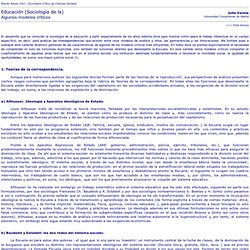

Diccionario Crítico de Ciencias Sociales. El desarrollo que ha conocido la sociología de la educación a partir especialmente de los años setenta sirve para mostrar como opera el trabajo intelectual en un campo específico, es decir, para analizar las interdependencias que existen entre unos modelos de análisis y otros, las permanencias y las innovaciones.

Me limitaré pues a subrayar este carácter dinámico partiendo de las características de algunos de los modelos críticos más influyentes. En todos ellos se plantea explícitamente la necesidad de comprender no solo las funciones explícitas, sino también las funciones latentes que desempeña la Escuela. En este sentido estos modelos críticos comparten el cuestionamiento de aquellas otras teorías que ven en el sistema escolar una institución destinada fundamentalmente a favorecer la movilidad social, la igualdad de oportunidades, en suma, una mayor justicia social (1). Practica Reflexiva - Metodologías Formativas Basadas en la Reflexión. Portafolio Reflexivo del Profesor de E/LE. EA.Piaget%20_%20Papert. Sharism: A Mind Revolution. With the People of the World Wide Web communicating more fully and freely in Social Media while rallying a Web 2.0 content boom, the inner dynamics of such a creative explosion must be studied more closely.

What motivates those who join this movement and what future will they create? A key fact is that a superabundance of community respect and social capital are being accumulated by those who share. The key motivator of Social Media and the core spirit of Web 2.0 is a mind switch called Sharism. Sharism suggests a re-orientation of personal values. We see it in User Generated Content. Sharism is encoded in the Human Genome. Thus, our brain supports sharing in its very system-nature. However, daily decisions for most adults are quite low in creative productivity, if only because they've switched off their sharing paths. These mind-switches are too subtle to be felt.
Non-sharing culture misleads us with its absolute separation of Private and Public space. Situating Constructionism. By Seymour Papert and Idit Harel The following essay is the first chapter in Seymour Papert and Idit Harel's book Constructionism (Ablex Publishing Corporation, 1991).

It is easy enough to formulate simple catchy versions of the idea of constructionism; for example, thinking of it as "learning-by-making. " One purpose of this introductory chapter is to orient the reader toward using the diversity in the volume to elaborate--to construct--a sense of constructionism much richer and more multifaceted, and very much deeper in its implications, than could be conveyed by any such formula. My little play on the words construct and constructionism already hints at two of these multiple facets--one seemingly "serious" and one seemingly "playful. " The serious facet will be familiar to psychologists as a tenet of the kindred, but less specific, family of psychological theories that call themselves contructivist.
They are not the only ones who are so predisposed. Footnotes References Harel, I. (1991). Minds on Fire: Open Education, the Long Tail, and Learning 2.0. KnowingKnowledge_LowRes.pdf. Connectivism: A Learning Theory for the Digital Age. Connectivism: A Learning Theory for the Digital Age December 12, 2004 George Siemens Update (April 5, 2005): I've added a website to explore this concept at www.connectivism.ca Introduction Behaviorism, cognitivism, and constructivism are the three broad learning theories most often utilized in the creation of instructional environments.

Learners as little as forty years ago would complete the required schooling and enter a career that would often last a lifetime. “One of the most persuasive factors is the shrinking half-life of knowledge. Some significant trends in learning: Many learners will move into a variety of different, possibly unrelated fields over the course of their lifetime. Background Driscoll (2000) defines learning as “a persisting change in human performance or performance potential…[which] must come about as a result of the learner’s experience and interaction with the world” (p.11).
Driscoll (2000, p14-17) explores some of the complexities of defining learning. Conclusion: 11 ideas clave: cómo aprender y ... - Antoni Zabala, Laia Arnau. Nuevas formas de aprender: el conectivismo. Se esta produciendo una nueva forma de abordar el aprendizaje.

Se rompe con la tradicional relación profesor-alumno, donde el profesor es portador de un saber que transmite de forma pasiva a los alumnos. El aprendizaje pasa a ser una conversación, el profesor cambia su rol y pasa a ser un facilitador, tutor, dinamizador. El aprendizaje se produce de forma bidireccional y es construido entre todos, compartiendo, colaborando, creando, relacionando conceptos.
La Web 2.0 se convierte en un entorno ideal para este modelo de aprendizaje. Podemos hablar de aprendizaje 2.0. El conocimiento no lo tiene el profesor en exclusividad, sino que es compartido con el grupo. Johnson (Johnson, 1992)2 y Lundvall (Lundvall, 2002) 3, describen los modelos de aprendizaje 2.0. Tomado de ISTE – Sociedad Internacional para las TIC en Educación 5.
Networked student - 13 Translation.